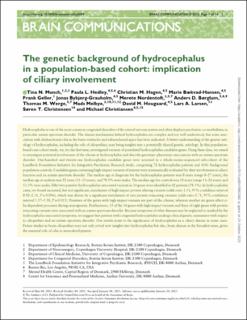| dc.description.abstract | Hydrocephalus is one of the most common congenital disorders of the central nervous system and often displays psychiatric co-morbidities, in particular autism spectrum disorder. The disease mechanisms behind hydrocephalus are complex and not well understood, but some association with dysfunctional cilia in the brain ventricles and subarachnoid space has been indicated. A better understanding of the genetic aetiology of hydrocephalus, including the role of ciliopathies, may bring insights into a potentially shared genetic aetiology. In this population-based case-cohort study, we, for the first time, investigated variants of postulated hydrocephalus candidate genes. Using these data, we aimed to investigate potential involvement of the ciliome in hydrocephalus and describe genotype–phenotype associations with an autism spectrum disorder. One-hundred and twenty-one hydrocephalus candidate genes were screened in a whole-exome-sequenced sub-cohort of the Lundbeck Foundation Initiative for Integrative Psychiatric Research study, comprising 72 hydrocephalus patients and 4181 background population controls. Candidate genes containing high-impact variants of interest were systematically evaluated for their involvement in ciliary function and an autism spectrum disorder. The median age at diagnosis for the hydrocephalus patients was 0 years (range 0–27 years), the median age at analysis was 22 years (11–35 years), and 70.5% were males. The median age for controls was 18 years (range 11–26 years) and 53.3% were males. Fifty-two putative hydrocephalus-associated variants in 34 genes were identified in 42 patients (58.3%). In hydrocephalus cases, we found increased, but not significant, enrichment of high-impact protein altering variants (odds ratio 1.51, 95% confidence interval 0.92–2.51, P = 0.096), which was driven by a significant enrichment of rare protein truncating variants (odds ratio 2.71, 95% confidence interval 1.17–5.58, P = 0.011). Fourteen of the genes with high-impact variants are part of the ciliome, whereas another six genes affect cilia-dependent processes during neurogenesis. Furthermore, 15 of the 34 genes with high-impact variants and three of eight genes with protein truncating variants were associated with an autism spectrum disorder. Because symptoms of other diseases may be neglected or masked by the hydrocephalus-associated symptoms, we suggest that patients with congenital hydrocephalus undergo clinical genetic assessment with respect to ciliopathies and an autism spectrum disorder. Our results point to the significance of hydrocephalus as a ciliary disease in some cases. Future studies in brain ciliopathies may not only reveal new insights into hydrocephalus but also, brain disease in the broadest sense, given the essential role of cilia in neurodevelopment. | en_US |

